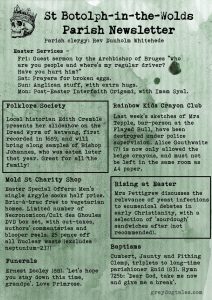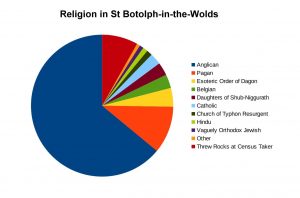Do you lie awake at night and panic about St Botolph-in-the-Wolds? Do you find yourself one of the many tens of thousands of people today who fear being abducted by feral girl guides high on metal polish and lemonade? Or do you just see a huge night-black, slightly psychotic pony lurking on every street corner, watching you? Worrying, huh?
To make it clear that these are real fears, here is our updated brief guide to St Botolph-in-the-Wolds, in darkest Yorkshire – the village which made Stephen King wet the bed, and caused Guillermo del Torro’s refusal to film in Northern England ever again.

For those new to the subject, St Botolph-in-the-Wolds might be described as a sleepy English Parish set in the rolling countryside of East Yorkshire, far from the hustle and bustle of city life; a village where everyone knows their neighbours, and life is much the same as it was centuries ago.
This would be a stupid description. It may be geographically correct, but life in St Botolph’s is complex, argumentative and filled with new terrors every day. More than one resident dreams of escaping rural existence to find peace in a violent urban crack ghetto, surrounded by burning tyres and daily police raids. People may indeed know their neighbours, but they may not always be sure what those neighbours are.
St Botolph’s is a diverse community, with – as we have suggested – serious doubts even as to the humanity of some inhabitants, though it is particularly hostile to Methodists and very welcoming to Belgians. Skin colour is rather irrelevant; the locals already practice such an inventive range of deeply-entrenched prejudices that they don’t have time for racism.
Members of the Women’s Institute are heavily armed, and the local Girl Guides are seriously dangerous, with a long-term Brasso addiction. St Botolph’s Mixed Infants has its own howitzer, and Mrs Gayamurthi’s All-Nite Wholefood Shop (closes 9pm) provides the most flammable naan in the Western hemisphere, along with her famous Mango’n’Pilchard ice-cream.
Scholars are divided as to what makes St Botolph’s so unusual. There is no doubt that the looming presence of Whateley Wood, north of the village proper, plays its part. Home to the oak, the Western Hemlock and an especially offensive type of briar, the woods contain many remains of early fertility and sacrificial cults. These include obscenely carved altars – where the Womens’ Institute leaves offerings of home-made raspberry jam at key times of the year – and a gleaming black stone from antiquity, whose surface is chill and moist even on the hottest day. This stands alone in a clearing which smells of charred bone, and is marked ‘Pickering 14 miles’. The sheer malevolence of the woods can be seen from the fact that Pickering is not actually 14 miles away. And it’s in the other direction.
Paths through the woods often appear and disappear at random. The unwary traveller may find themselves lost in a ravening gloom, surrounded by nightjacks and tendrilled things – or worse, may end up at Malton bus station. The main section is also inhabited by a large colony of bronchitic whip-poor-wills. Normally typical of the witch-haunted hills of New England, these small, coughing birds are always on the lookout for souls to conduct into the Afterlife.
Or perhaps its origins are to blame. It has been variously claimed that the village started life as:
- A Bronze Age ritual site for the disposal of unwanted otters
- A shrine to Botothqua, Mother of Persistent Slime, worshipped by at least three people in the early Iron Age but somewhat neglected since 557 BCE*
- An open toilet for the Auxiliary Roman Cavalry unit based at Malton
- A failed attempt at creating a refuge for agoraphobic Vikings
*See ‘Mucus and Myth: The Peculiar Deposits on some Northern La Tene Artifacts’, Ichabod James Marsh (BChD), Journal of Unreliable Archaeology, XVI, pp23-48)
There is no single agreed origin for the settlement. Stories of the past, many of them highly dubious, are common currency in St Botolph’s. There is no doubt, though, that in Victorian times the village was genuinely home to Ebediah Crake, the least successful Wolds murderer in history. J Linseed Grant says of him:
“In 1839 he failed to kill an entire family of seven living just outside York, being distracted by ‘a littul kitten what had a poorly paw.’ And in September 1842, Crake helped a frail old lady into a carriage and then secured her luggage to the rear, telling the driver to go gently. His actual instructions, from one Septimus Grange, an itinerant ferret-grinder, had been to garotte her and leave the body in a ditch so that they could share the contents of her purse. Grange was later hanged for interfering with two unrelated goats.”
There are many other fascinating examples of myth and folklore in the area. The tale of mist-shrouded Cooper’s Field, northwest of the village, is always popular during Ramadan:
“Legend had it that a skilled cooper once set up his trade there, relying on the woods to supply timber for his intricately fashioned barrels. Not long after, he died.”
It isn’t much of a legend, to be honest, though there are more worrying ones, such as that of the St Botolph Grinder…
“Last Thursday’s talk at the Church Hall resulted in very few people being hospitalised. It included a rousing presentation on the nature of the St Botolph Grinder, a brutal spirit with adamantine teeth which extracts the bones from local children, but leaves a shilling on their pillow afterwards. Or a tangerine. Local historian Edith Cremble amused the mostly intoxicated audience with her comparison of the Grinder to the Appalachian slaughter-wife, a similar myth common in Western Canada (despite being surprisingly violent, the slaughter-wife has no sense of direction). The talk ended with an open discussion on the role of metal polish in English folklore, and whether or not anyone could remember where the nearest bus stop was.”
LEGENDS OF OLD ST BOTOLPH’S No.64: The Blessing Stones
“Certain curiously shaped stones can be found in the Wolds, and these are said to offer protection against the creatures of evil. When examined closely, a number of the larger stones also have arcane markings and script, such as ‘My other stone’s sedimentary’ and ‘Call 577432 to advertise on this stone’. And it is true that if you throw enough of these warped rocks at the monstrosities of the night, you might at least give them a broken tooth or two before they drag you down.”
St Botolph-in-the-Wolds is also on the edge of the Wold Newton Triangle, an area long know for its strange meteorites, disappearing rivers, early mounds and so forth. So that probably helps. With Grimdyke Moors, Buttersmite Fell, Whateley Wood and a range of stark, haunted crags surrounding the village, Yorkshire temperament must play a part in keeping humanity present in a location for which it is hardly suited. That, and a poor sense of direction.
Despite the fact that the Ordnance Survey have refused to mark St Botolph’s on the official maps, citing public safety concerns, certain authorities such as the military are aware of it. RAF pilots, for example, have strict instructions not to fly over the area, ever since one of the Tornadoes from Staxton Wold came back with more wings than it had when it set out.
Given the above, it is perhaps no surprise that religion plays a large part in local life:
But we must be away, and we should be remiss if we did not mention that famous protective spirit which guards the sanctity of the Parish, occasionally crippling parish members by accident (or when in a bad temper). Born in a barn on what is often referred to as ‘the farm’, the coal-black, slightly psychotic pony known as Mr Bubbles is known to fight the forces of evil far and wide across the Wolds. Unless he is bored, or hungry, at the time. Teamed with his cheerful (and only) friend Sandra, plus occasionally her cousin Mary and his lurcher Bottles, he is the colossus which bestrides the area – but with more legs.
MR BUBBLES AND THE BLACK HEART OF CHAOS
A thrilling weird fiction story by J Linseed Grant
The hunched acolyte flung back its cowl to reveal a face that spoke of the long dead, the sleepless dead who claw their way through worm-mark and rotting coffin-wood to drag air into lifeless lungs. The eyes were blank, glassy, no longer fit to measure the world above; the splayed nostrils ran with foul and discoloured ichor.
“He is the Void, and the Heart of the Void,” it cried, “The Primal Chaos to which we must return. He is the Insanity which even madmen cannot bear!”
Mr Bubbles munched on a mouthful of particularly juicy couch-grass. His backside itched.
“He is…” The acolyte squinted, and one eyeball slithered onto its cheek. “He is the God feared by Gods, the bubbling, insensate core of All!”
“You should get out more,” said the pony, and trod on the acolyte rather firmly.
Later, he found a parsnip, which was nice.
The Journal of J Linseed Grant is explored every few days in jlg’s Facebook entries, usually with dire results, and the occasional Mr Bubbles tale turns up there as well. All posts are public, so you don’t even have to pretend to be a Friend, though if you Follow you might get warned! St Botolph-in-the-Wolds features in many stories on greydogtales (and the odd one elsewhere). If you want a sample, you could try this heartwarming story of a simple village play…
http://greydogtales.com/blog/the-wreck-of-the-natividad/
So farewell for now, and remember – your nightmares are Nature’s way of telling you that you;’re doomed…




